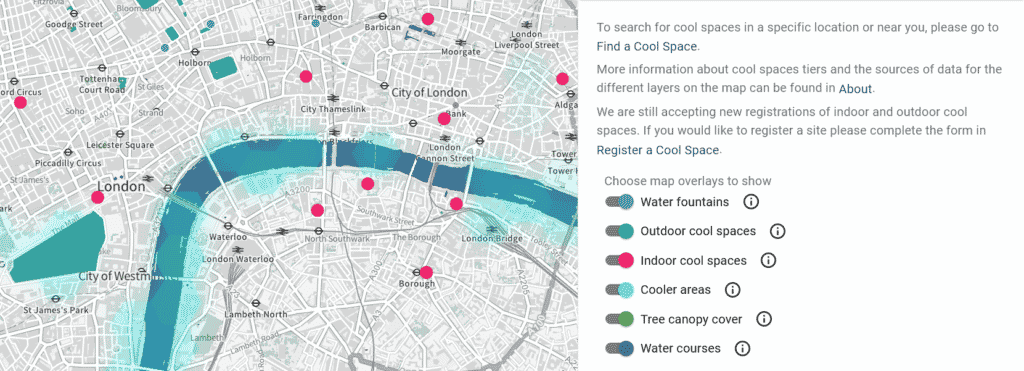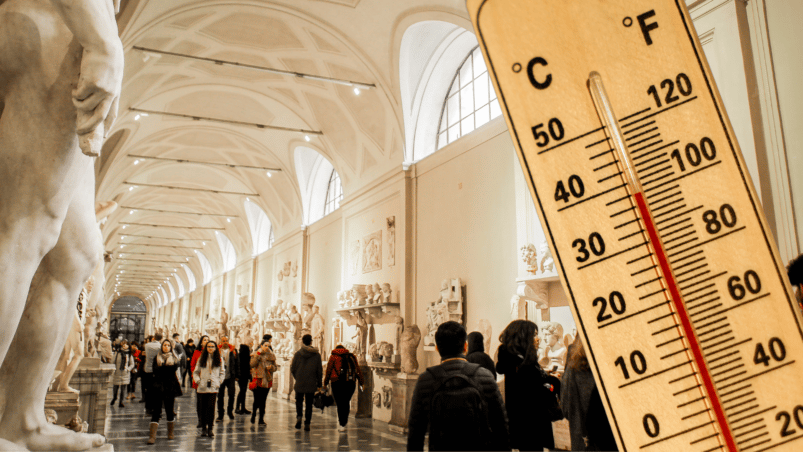Europe is sweating and puffing during the current heatwave. Since not everyone can buy expensive airconditioners or isolate their homes, it is quite a task to keep cool during these extreme temperatures. Initiatives in Belgium, the UK and France turn their attention towards museums and heritage sites to keep groups at risk cool.
In the UK and France, several cities decided to offer free access to cooler spaces for citizens to survive the heatwave, Eurocities reported. Museums, libraries, community centres, swimming pools and sports arenas provide shelter from the warmth, as not everyone has the possibility to properly cool their homes or flee to the countryside.
While in Europe’s southern regions traditional homes feature thick walls, smaller windows and large shaded areas to offer shelter from the sun, buildings in Northern Europe were historically made to attract and keep warmth inside due to the colder climate. As heat plans and ‘Cool spaces‘ maps are launched, multiple museums and heritage sites step in and make sure the public keeps cool.

Free access
In Brussels, the Belgian Secretary of State for Scientific Policy Thomas Dermine launched an interesting initiative: people over the age of 65 and their companions can visit federal museums for free during the heatwave. The idea is to allow those that are most sensitive to the heat to take advantage of the air-conditioned spaces while discovering the collections at the BR Museum, Museum of Ancient Art, Fin de Siècle Museum, Museum of Natural Sciences, Royal Museum for Central Africa, Art and History Museum, the Brussels Times reported.
“The primary mission of our major museums is obviously to highlight a collection, but they are also institutions open to society and at the service of the population,” Dermine commented. “Their spaces, which are effectively public spaces, must be made fully available to vulnerable people in the event of extreme weather events.”
For example, the cities of Bordeaux, Toulouse and Grenoble in France launched similar initiatives. Here, citizens younger than 65 could visit museums for free as well, as municipalities check up on isolated and vulnerable people.
Reaching the vulnerable
But why are museums such a great place to shelter people from the scourging heat? “Museums often have thick walls and environmental controls which keep a steady temperature”, writes Jess Turtle for the Museum Association. “Combined with access to toilets and water this could be a life-saving scenario for people who are susceptible to extreme heat.”
Not only senior citizens should be regarded as a group at risk of dying from hot temperatures. Turtle reckons that especially homeless people suffer and die during the summer months, as the Dying Homeless Project shows. The initiative tracks and remembers those who die while homeless in the UK.
Municipalities can give important roles to museums and heritage sites as inclusive ‘cool spaces’ in their future heat plans
Turtle, who is the co-founder of the project, notes that it is not as simple as launching a ‘Cool Spaces’ app or putting out a press release. Often there are psychological, emotional or literal barriers that block out homeless people. Small initiatives such as providing signage, a welcoming environment, free water or designating a quiet space can often make a museum space more inclusive to all.
As multiple experts warn that these extreme weather conditions could become the norm in coming years due to climate change, public institutes such as museums can become key in surviving the heat. Authorities such as the municipality can give important roles to museums and heritage sites as inclusive ‘cool spaces’ in their future heat plans. It allows the public to keep cool, highlight the collections on display and possibly reach a new audience.
Source: Brussels Times, Eurocities, Museum Association and Politico

